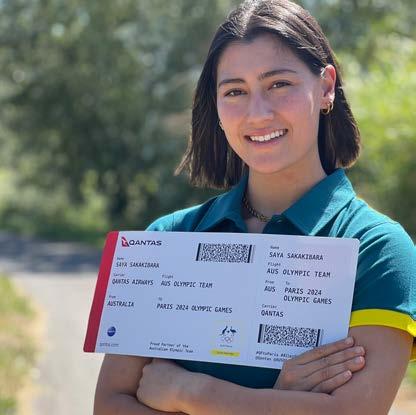




Saturday at City Diggers Club in Wollongong
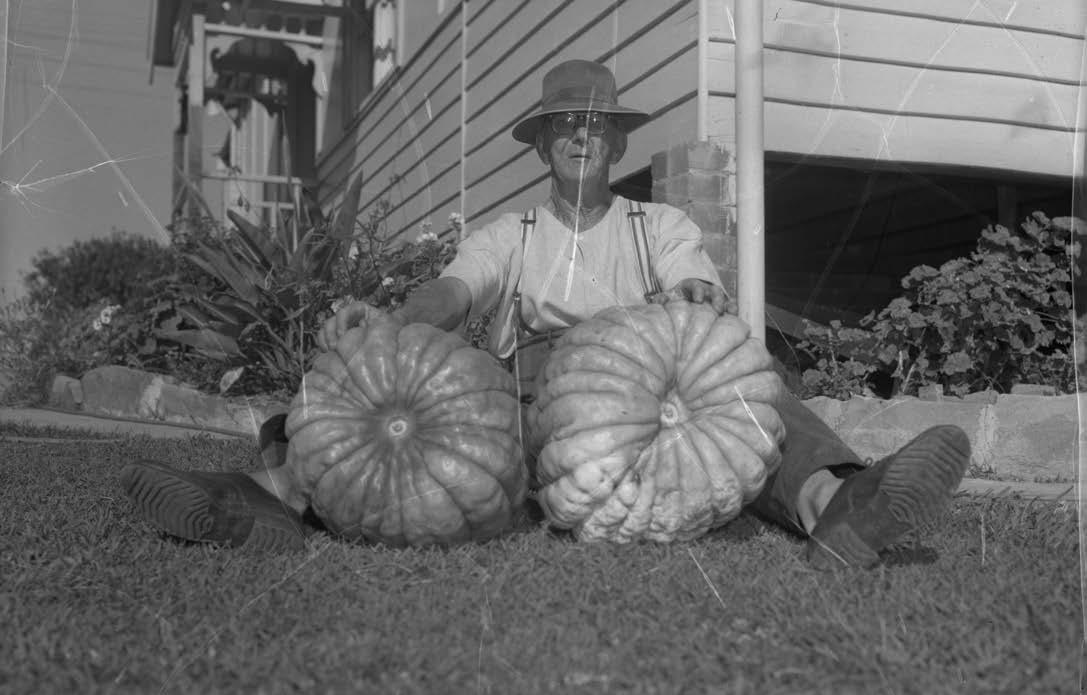
To celebrate National Family History month in August, the Illawarra Family History Group Inc. are hosting a Family History and Heritage Fair on Saturday, 17th August at the City Diggers Club in Wollongong from 10am to 4pm. Admission is free and the Fair is open to the public.
IFHG President Judy Bull says that, “The Fair will showcase the diversity
of heritage in the Illawarra area. There will be participants representing family history, local history, heritage crafts, heritage transport, local museums, Wollongong City Library, State Archives, U3A and the University of Wollongong.”
A raffle will be run on the day with great prizes.
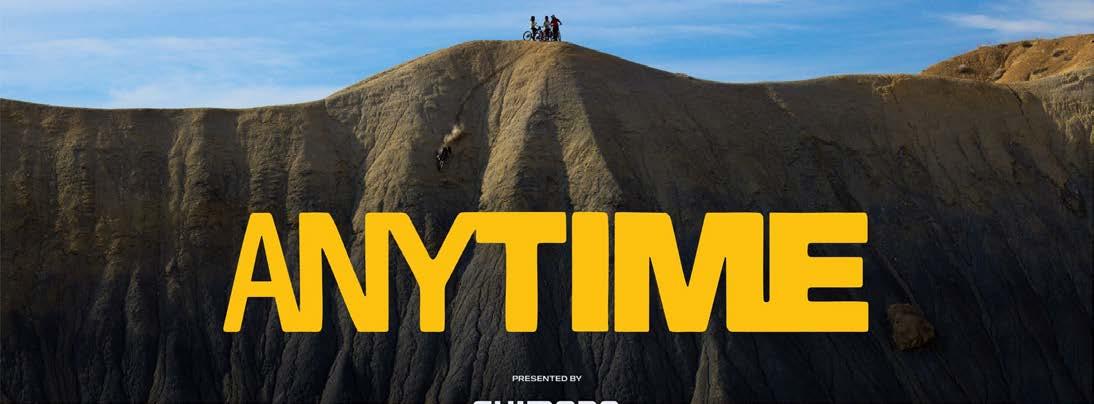
Watch MTB film
All proceeds to Wollongong Mountain Bike Club
Join Wollongong MTB Club for the premiere of “Anytime”, a new mountain bike feature film to be released from Red Bull and Anthill Films.
Directed by Darcy Wittenburg, the film features top freeride mountain
bike athletes pushing the boundaries of their sport in challenging and previously unridden terrains around the world.
7pm tonight, August 16, at the Gala Cinema Warrawong. To purchase tickets, click here.

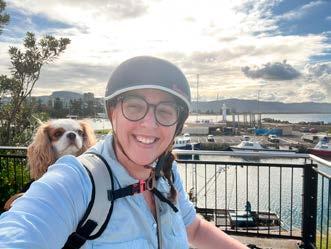
Sept Folk by the Sea Click here for more events
Words & photos by Tyneesha Williams

Powered by more than 150 volunteers, Illawarra Cancer Carers (ICC) has been providing support for cancer patients for 34 years.
President Narelle Langridge says that there is a role for every volunteer at ICC.
“I started nine years ago. I woke up one day and thought ‘I want to do some volunteering’,” she says.
“I started out driving patients to the hospital and to their appointments. Nine years later, here I am.”
Along with their driving service, ICC offers support to cancer patients experiencing a wide range of issues.
“We’ve got turbans and breast cushions – so if anyone needs them, they can just pop in and grab one. We don’t charge them for that,” Narelle says.
“We need more people to go into the hospitals because they’ve just opened up ward 7 at Wollongong Hospital again – just to chat and make them a cup of tea and things like that.”
The organisation also offers free sessions at the lymphoedema clinic in Dapto and can provide financial help for patients facing hardship. Member Patricia Hearn says that cancer treatment often involves unexpected costs.
“They get sick, they’ve got to go to the doctors, they’ve got to pay the extra money, they’ve got to get to their appointments and back,” Patricia says.
“But then the phone bill hasn’t been paid, because they’ve been getting treatment. And the electricity bill hasn’t been paid because they’re getting
treatment. So when we can, we’ll help them out and pay those bills for them.”
Recently ICC fundraised $47,500 to support cancer research at the University of Wollongong, raising funds through stalls, raffles, and their annual Banquet at The Beach event.
This year’s Banquet at The Beach will be held on Sunday, October 27 at City Beach Function Centre, Wollongong. Chairperson Patricia Hearn invites locals to come along and enjoy a three-course meal.
“For people just to stop what they’re doing and come and do that for us… it’s beautiful. The theme is ‘Come Fly With Us’. We’ll be dressed up as air hostesses,” Patricia says.
“We’ve got people that have volunteered to sing – so we’ve got an acapella group, Out of the Blue, performing for us, and Anthony Snipe has volunteered to sing around lunchtime.
“There’s lots of fun things to do – games to play and prizes to win, as well as our stall with the sewing ladies.”
ICC sewing group meets on Friday mornings at Dapto Showground. The
team uses donated materials to make a variety of items that are sold at ICC stalls to raise funds.
“People donate the wool and then people donate their time to make it, which is just beautiful,” Patricia says.
“It’s a real community. You go to our sewing group and there’s 20 or 30 people, but the network from those 20 or 30 people is amazing – they can take wool home and people can sit in their chairs and knit.”
Throughout August, Narelle and Patricia raised funds with a stall at Warilla Grove Shopping Centre. ICC sold clothes, homewares and toys made by the sewing group.
“People come in to chat and sometimes they’ll bring in things to donate from home,” Narelle says.
“Our prices are very reasonable, and we have so much to sell because so much is donated by the community.”
Locals wanting to volunteer with Illawarra Cancer Carers can find more info via their website, download their application form, follow ICC on Facebook or call Narelle on 0414 280 127.


“People donate the wool and then people donate their time to make it, which is just beautiful.”
– ICC member
Patricia Hearn
By Jeremy Lasek
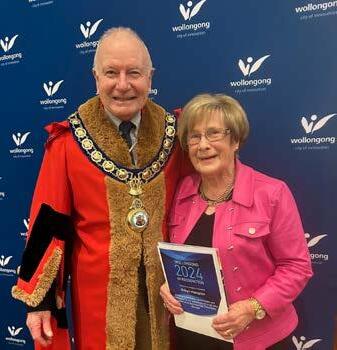
The Lord Mayor paid a special tribute to Robyn Hampton, the longest-serving member of the committee, who for more than 20 years has “had responsibility for our Australia Day baby”
Our departing Lord Mayor was in a jovial mood as he signed off this week, his last after 13 years in our city’s top job.
On Monday night, the current Council met for the last time, with five councillors choosing not to seek re-election when we vote on 14 September.
The following night, at the city art gallery, dressed in the Lord Mayoral robes, Councillor Gordon Bradbery performed his last official duty before retirement, recognising nearly 100 of our city’s ‘movers and shakers’ at the Lord Mayor’s Recognition Reception event.
Among those thanked and presented with certificates of appreciation were all of the most recent recipients of Australia Day and King’s Birthday Honours.
Also honoured were volunteers from the Wollongong Art Gallery. Elspeth McCombe has given an incredible 30
years’ service, while her colleagues, Cathy Briand James and Judy Goodley, were recognised for a decade of volunteering at our city’s cultural hub.
The Lord Mayor thanked the efforts of the Australia Day Committee, which he chairs.
He paid a special tribute to Robyn Hampton, the longest-serving member of the committee, who for more than 20 years has “had responsibility for our Australia Day baby” (the first baby born in our city each year on January 26).
Others recognised at the ceremony included Shaz Harrison from Need A Feed, the Friends of Wollongong Botanic Garden for 40 years’ service, David Bere for 30 years volunteering with the State Emergency Service (SES), Aunty May Button for Aboriginal initiatives and knowledge sharing, and Ian Garling for two decades of leading Whipbird Bushcare at Balgownie.
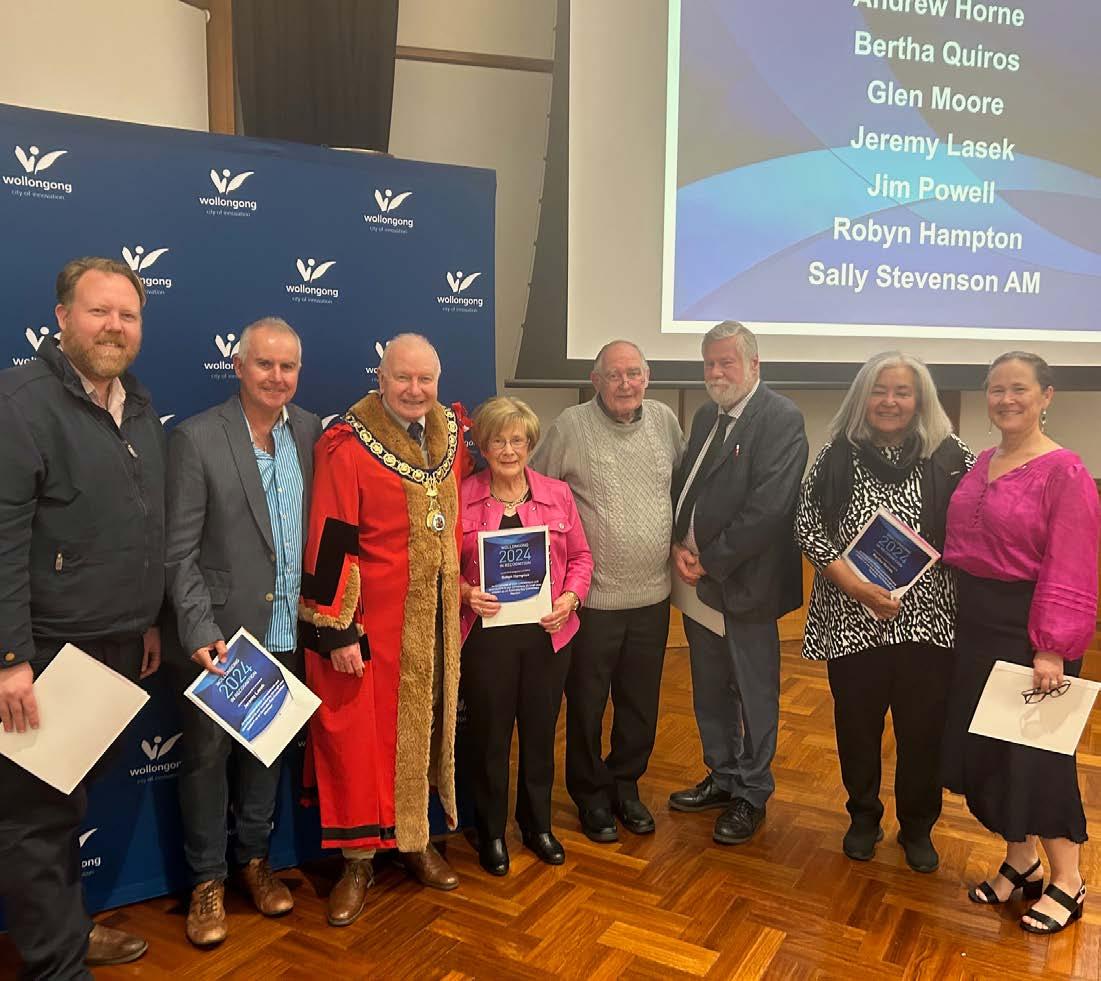
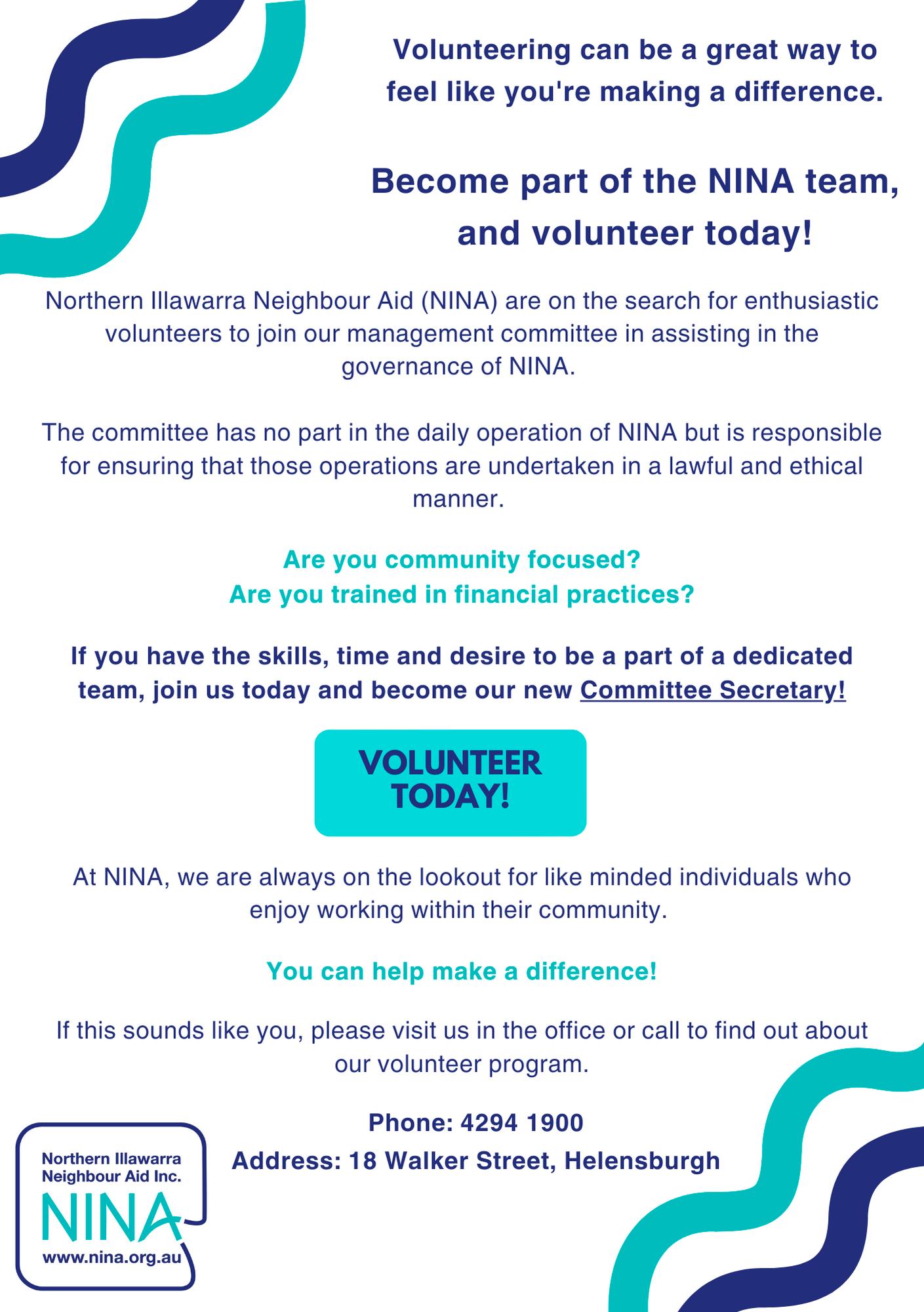
By Amanda De George

Thisis so exciting!” Ally Thomas exclaims as I walk in to Thirroul + Co. And it is exciting.
At just 24, Ally has taken over the reins of the much-loved Thirroul staple, a store involving 30 small businesses that is part boutique, part gift shop, part lifestyle hub.
Even more exciting is the fact that this isn’t even Ally’s first business. She also owns Malia The Label, a small-batch fashion house focusing on slow fashion, sustainability, timeless design and natural fibres.
Now that might seem a lot to take on but it was a natural progression for Ally, who was selling handmade cards locally when she was 12 or 13.
“Ever since I was young, I’ve had those little side projects,” she said.
However, it took a project in her Year
12 Design and Technology class to combine her love of drawing and sewing with her newfound appreciation for sustainability.
“I wanted to do something sustainable and I’m really artsy. My nan and my mum taught me to sew,” she said.
“I reached out to brands that used fabric for swimwear that’s made from plastics. I got their offcuts and I used them to make my own swimwear.”
But it was the Covid lockdowns of 2020 that proved to be a real turning point for Ally when she was introduced to Sheralee Rae, Thirroul + Co’s previous owner.
Remember when surgical masks were nearly impossible to come by and so we all turned to the more environmentally friendly material ones? Ally was making those in huge numbers and Sheralee was
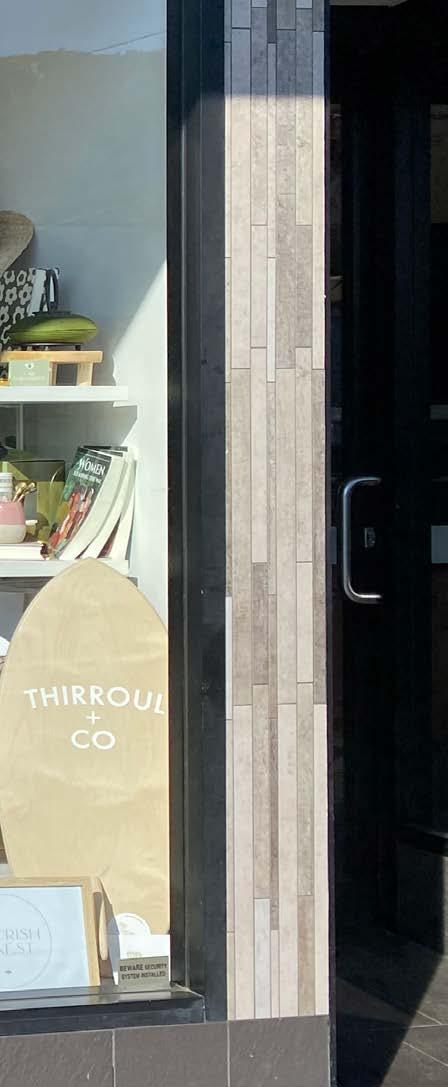
“I wanted to do something sustainable and I’m really artsy. My nan and my mum taught me to sew.”
– Ally Thomas
her number one customer.
Lockdowns also gave Ally a chance to use the skills that she was learning through the Billy Blue College of Design, a course that like so many others had to be moved online, and the time to reassess her own thoughts around fashion.
“I had so much spare time I ended up sewing up my own clothes. At the same time I was realising that a lot of the fashion in my wardrobe was the fast fashion, mass-produced, synthetic fibres and I was like this doesn’t fit with my values anymore.”
“From there, I started hand making a few pieces and I was doing made to order pieces for people, so I kind of just went for it during Covid and started my own clothing brand on a whim,” she said. “I’m like that, once I get an idea I just do it.”
As Malia The Label has evolved, Ally
has moved from making the pieces herself to working with small factory makers in Indonesia who bring her designs to life. She said, “With my creations, when it goes from an idea in my head to real, to someone wearing it, I’m like ‘oh my gosh, that’s so cool!’”
And now, as the new owner of Thirroul + Co, Ally is hoping to help other small businesses in the same way that Sheralee helped hers, inviting her label in store three years ago and offering plenty of mentoring.
“Now I’m so happy that I get to help other small businesses that may have been in the position that I was when I first started and help them to grow and flourish as a business too.”
You can find Malia The Label instore at Thirroul + Co, online and at local markets.

By Simone Potter
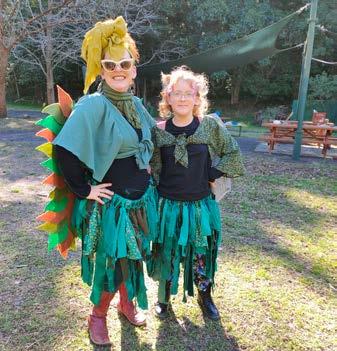
“Children were involved in planting native shrubs in the new garden beds, establishing a new bush tucker area, art and craft activities.”
– Simone Potter
OnSunday, July 28, nestled between Mullet Creek and the backdrop of the escarpment at Don’s Farm Avondale, Dharawal land, an enthusiastic crowd gathered to celebrate National Tree Day. It was a joint effort by Dapto Rotary, Bohmer’s Tree Care and Bush Magic Adventure Therapy. The three organisations are working together with common goals: to make the community strong around our kids and to care for our natural resources.
The result is a new and exciting environmental park that includes native flowering plants to attract bees and birds, some bush tucker trees and eventually will also include native bee hives.
Caring for the newly planted trees will be the job of children from Bush Magic Adventure Therapy, a bush school that uses Don’s Farm as a base for children to practise bush survival skills and work on their social and emotional learning.
The day also served as a launch for this new venture. The gathering included children and families who have been benefitting from the bush school and would like to see it expand.
The alliance between Dapto Rotary, Bohmer’s Tree Care and Bush Magic Adventure Therapy is building a strong community to ensure that our kids are supported to develop the skills they need to navigate life, while at the same time
looking after the environment that is so important to their wellbeing. Don’s Farm is a great space for kids to learn about nature and themselves.
Bohmer’s Tree Care partners with Bush Magic Adventure Therapy to provide funding for children to attend who otherwise would not be able to afford it. Dapto Rotary maintains the space and shares Bush Magic’s vision, working together to ensure the site is safe and accommodating to the children who attend and providing opportunities for the children to learn about and care for the environment.
On the day, children were involved in planting native shrubs in the new garden beds, establishing a new bush tucker area, art and craft activities run by Bohmer’s beautiful Tree Fairies and a nature scavenger hunt. Lunch was cooked by Dapto Rotary in their new BBQ food trailer. Rotary also installed and unveiled two Peace Poles, which were donated to promote peace in the community.
Although it was cold and windy, the weather didn’t seem to dampen the enthusiasm of the kids who were excited to dig holes and learn about how to plant and care for the trees, provided by Bohmer’s Tree Care. One child even turned up with his very own wheelbarrow, shovel and watering can.
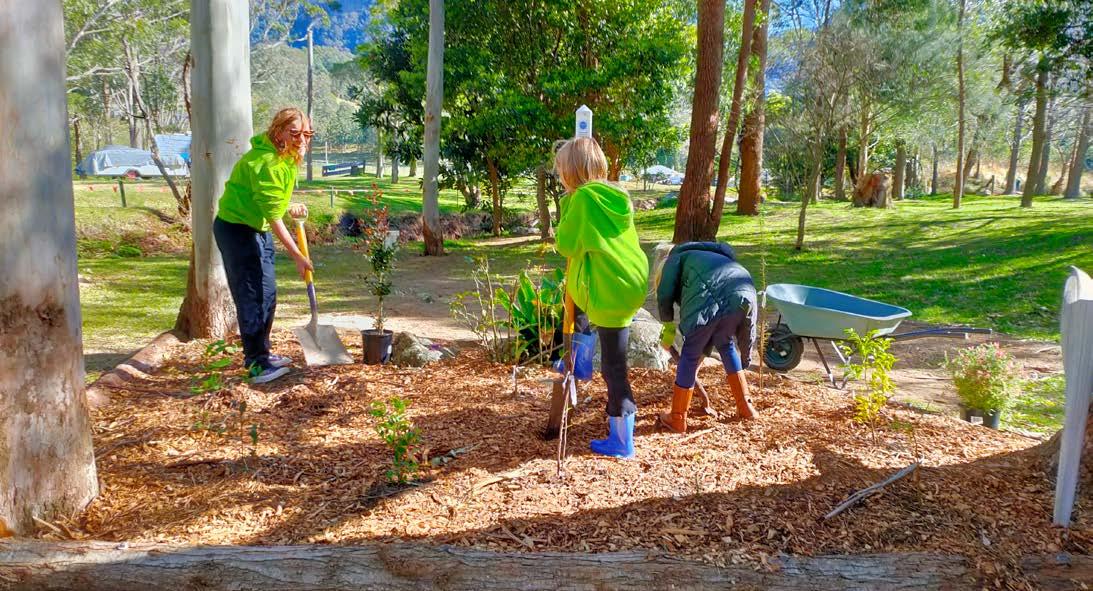

By Jeremy Lasek
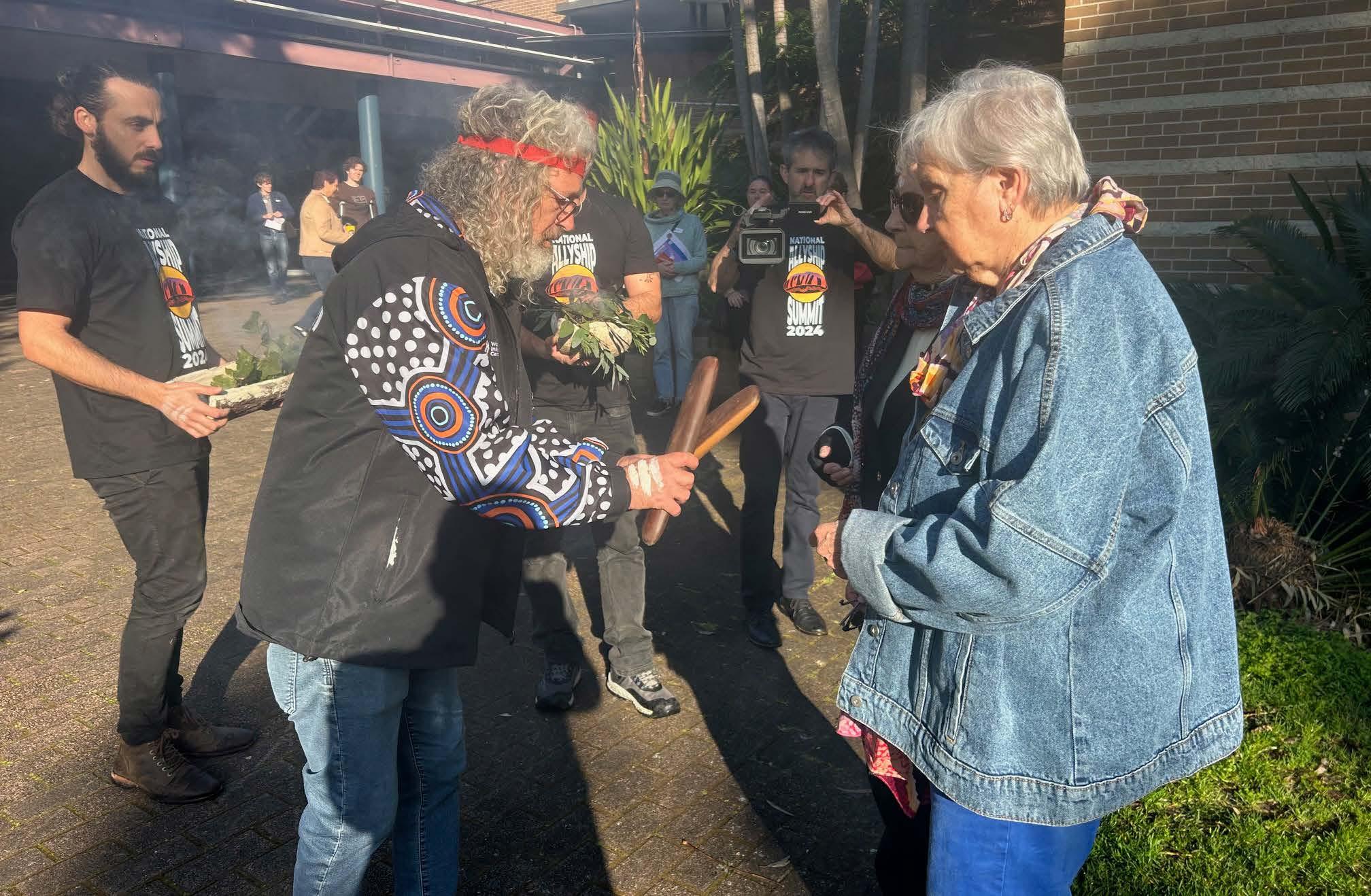
Stay true to Uluru. Those four words were the rally cry coming from a gathering of 200 people in Wollongong to mark World Allyship Day.
World Allyship Day was created on the eighth day of the eighth month to celebrate and promote the power of allyship across the globe.
Following a moving smoking ceremony in the crisp early morning on the University of Wollongong (UOW) campus, our 2024 Citizen of the Year, respected elder Dr Aunty Barbara Nicholson, provided the Welcome to Country at the first National Allyship Day Summit.
Gutted by the result of the 2023 Voice referendum, Aunty Barb confessed that she’d asked herself why she should
continue to accept invitations to do “Welcomes”.
Over time she realised “to not do Welcomes just keeps us invisible”, Aunty Barb said.
In her keynote address, Indigenous leader, Uluru Dialogue co-chair Aunty Pat Anderson AO, reflected on a lack of commitment from the federal government since the “heartbreaking” referendum defeat and the comments made by PM Albanese at the Garma Festival about his commitment to the Makarrata.
“I’m certainly getting a sense of déjà vu. That familiar feeling when retail politics and short-termism start to motivate the abandonment of a key Indigenous reform,” Aunty Pat said.
“I worry that we will see the Makarrata baby thrown out with the referendum bathwater.
“I hope I’m wrong, but we’ve seen that politicians can be fair weather friends, and when I see that, it makes me more grateful for our steadfast allies.”
Aunty Pat said the greatest thing to come from the referendum was discovering “we have 6.2 million friends we didn’t know we had”.
UOW Vice President (Indigenous Strategy & Engagement) and the leader of Woolyungah Indigenous Centre, Jaymee Beveridge, spoke of the importance of allies, especially after the disappointment of the referendum result.
“Today, we come together to discuss and deepen our understanding of allyship and to explore how we can collectively support the Voice, Treaty, and Truth processes outlined in the Uluru Statement from the Heart. Our goal is to foster meaningful dialogue, build stronger relationships, and inspire action towards justice and equity for Aboriginal and Torres Strait Islander peoples,” Jaymee said.
South Coast Labour Council president Arthur Rorris reflected on referendum day, and the counting of votes.
“On the night, we didn’t really like what we were seeing up there in the town hall with the numbers on the board. But the feeling of solidarity in the room was just incredible and even though we had
lost the vote nationally we knew we had a lot of friends, and a lot of solidarity and hope,” Arthur said.
The trade union leader said allyship was the future and was the only way to counter the type of division created by the No campaign
“They want misery to be the currency and continue to be the focus … We can offer something those people will never be able to do, and that is a future, and that’s where the hope comes from.”
One of the leaders of the national Yes campaign, author and activist Thomas Mayo, challenged the many young people who voted Yes to step up.
Thomas’s soon-to-be released book, Always Was, Always Will Be, dedicates the first chapter to ‘hope’.
Jaki Adams, who leads Social Justice at the Fred Hollows Foundation, told the summit, “Hope is what keeps me going; it’s what drives me.”
Researcher and author Professor Bronwyn Fredericks said despite the dominance of the ‘No’ vote, supporters of the Uluru Statement should take heart.
“We have 6.2 million friends. Don’t be strangers, allies – and bring others into your circle,” Bronwyn said. “Stay true to Uluru. Policies and politicians come and go. But we will always be here.”
Thomas agreed: “Don’t be afraid to introduce friends to our people and our culture. A lot of people voted No in the referendum because they didn’t know us.”
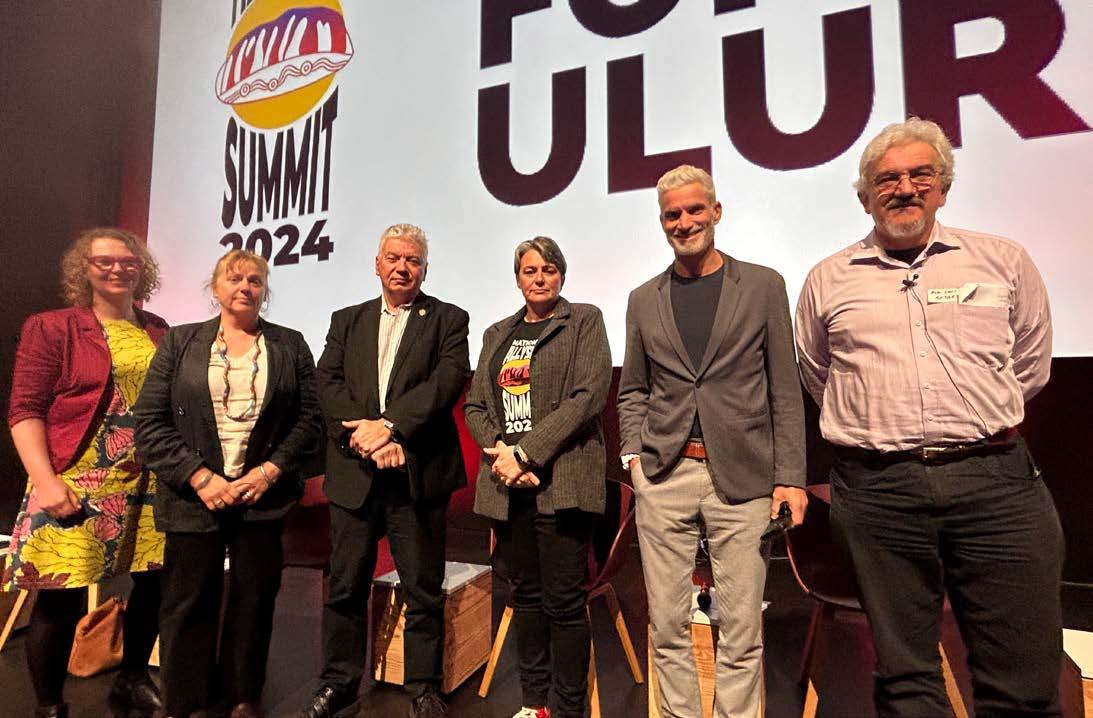
“Don’t be strangers, allies – and bring others into your circle. Stay true to Uluru. Policies and politicians come and go. But we will always be here.”
– Professor Bronwyn Fredericks
By Emma Rooksby of Growing Illawarra Natives

“It’s used as a lawn grass or ground cover in shady and part-shade areas.”
– Emma Rooksby
Running Postman! What images does that conjure?
For those of older generations, perhaps the thought of a postie on foot, running from house to house to deliver letters containing important messages, perhaps pushing through sleet and snow. Possibly wearing a colourful red and yellow uniform? I’m not sure, and I have to say that the common name of the beautiful local climber Kennedia rubicunda has me pretty mystified.
On the upside, it’s a lovely plant and extremely hardy and adaptable. You can see it around the Illawarra region in almost all local plant communities, where it will pop up in sunny spots on the edges of eucalypt forest or rainforest or in among coastal scrubland without a care in the world. And when it’s in flower, as it is now, it looks spectacular.
Pictured above left is a vigorous Running Postman plant growing happily at Puckey’s Estate in Fairy Meadow. (Image by Emma Rooksby.)
Running Postman is an excellent garden plant, due to its toughness and versatility. It copes with a range of soils, including sandy and clay soils, but generally prefers part or even full sun. You won’t see it deep in the rainforests of
Prepare your trees for windy days
Thanks to the team at Tip Top Trees

the escarpment. Another positive of Running Postman is that, as a member of the Fabaceae family, it is able to fix (store) nitrogen from the atmosphere, something that most plants cannot do; it means they can thrive in situations where limited soil nitrogen is a limit on plant growth for other species. The nitrogen fixed by a Running Postman, or other Fabaceae plant, is then available to other plants once it dies.
Below is a close-up of a Running Postman flower. (Image by Stephanie Mackie-Schneider.) Running Postman plants are flowering profusely right now, in woodland, coastal scrub and healthlands right across the region. Get out and see them while you can.
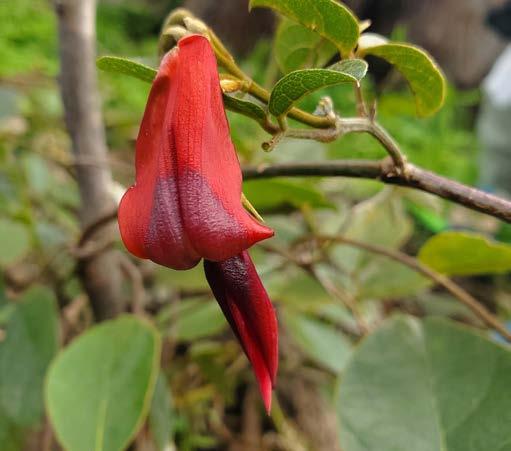
Aside from short days and cool temperatures, winter often also brings the challenge of blustery, gusty winds.
While we can’t control the weather, we can take steps to make sure our trees stay healthy and safe. In this article, the experts at Tip Top Trees share easy, proactive maintenance tips to help your trees weather the storm.
1. Ensure your trees get regular check-ups. Just like you visit the doctor for a check-up, your trees need regular inspections too. Aim for at least once a year, especially before the windy season hits.
Click here for more advice from Tip Top Trees


By Wollongong psychologist Jo Lunn

“You can tell if the motive is to outrage you, as the presenter might use excessive sarcasm, a sense of superiority or derogatory language to describe large groups of ominous others.”
– Jo Lunn
Theaim of this article is to give useful tips to help analyse information we come across so we can avoid getting tangled up in targeted disinformation and/or groupthink and make up our own minds on important issues.
Misinformation is when something is presented as being factual, but it is not, for example, blue has been scientifically proven to be the best colour. Misinformation thrives when people are motivated by emotion to share it with the ‘don’t eat me’ brain. Our motivation to share increases when we feel angry or scared. This misinformation we pass onto others, often via social media. Sometimes, it is passed on because we believe it to be true and feel strongly about it. Other times we can share misinformation with others out of habit and without thinking about it too much. Either way the intent is not to deliberately give people the incorrect
information. Disinformation is different. People or organisations spreading disinformation, do so deliberately. Knowingly spreading lies or half-truths, presented as facts, to target our ‘don’t eat me’ brains. Why? Money and power.
How to reduce Misinformation and Disinformation – recognise CRAAP when you see it
How do we find out the facts or the ‘truth’ about something important to us?
How current is the information you are looking at – when was it printed, published, uploaded? Is there newer, more accurate information available? This is very important when we are searching for information online. How old is the video, story, article? Even if it was uploaded
yesterday – how old is the information the story is using? For example, it might be a new post by a blogger but the reports they are using as facts were published 15 years ago.
Am I getting all the relevant information about a topic? Is the information I am looking at relevant to what I am interested in? Internet search engines, Facebook and TikTok change what we see depending upon what we look at and the amount of time we spend looking at it. They want to know what we are interested in so they can keep us online and looking at their advertisers’ products, so they can make money. If we look at something for a time, similar articles, videos etc will be sent to our feeds. This is fine if we like cat videos, but when we are trying to understand complicated topics, we are often getting only one side of the story. Universities have great free online resources to help you find relevant information.
What are the presenters’ qualifications?, e.g. have they studied the topic for 15 years or did they just do a three-hour google search? Are they actually an expert in the area they are commenting on – you wouldn’t get a builder to take out your appendix, just like you wouldn’t get your surgeon to build your home. Is there consensus between experts? There is always disagreement and diversity of opinion, especially in science and we want that, as exploring multiple perspectives is a human superpower. But if you have one expert who says something is red and 100 saying it is blue, consensus really needs to weigh into your evaluation of the information. Is the presenter being paid for the information? What is their motive for sharing it? If money, power or prestige are involved, be cautious!
Did the presenter use broad sweeping statements like “everybody knows” (who
is everybody?), “it makes sense” (to who?), “they don’t want you to know about this” (who is they?), “many scientists are now saying” (which scientists – where are they saying this and what exactly are they saying – for example did the presenter take one line of 600-page report and use it out context?).
If what you’re reading has a reference to other sources of information, for example, if it uses data, research, a report, a graph or an organisational endorsement, look up that source of information and make up your own mind. References can be unintentionally or intentionally misquoted or in some cases might not even exist at all!
Consider joining your local library, your librarian can help you look up information from a wide range of sources. Your librarian can also help you access information that is used to judge the accuracy of information, explaining terms like peer-reviewed articles, systematic reviews, for example. There are also fact checking links – there are some examples below to fact check topics of interest.
How is the information presented and why is it being presented in the way it is?
Media sources, whether they are TV current affair shows, social media or YouTube ‘influencers’, know that the angrier you are about what you are seeing, the more you watch. So, is information being explained to inform you or is it told in a way that pretends to inform you but is really designed to outrage you. This is called ‘rage-bait’.
You can tell if the motive is to outrage you, as the presenter might use excessive sarcasm, a sense of superiority or derogatory language to describe large groups of ominous others who disagree and are a threat.
The aim – the ‘us and them’ story.
If this is happening, chances are the facts are secondary to the money being made by selling our time to advertisers or a grab for power which is the underlying goal.
By Genevieve Swart

Last week a young Port Kembla scientist was celebrating a major achievement: having her first article published in Renew Economy, Australia’s clean energy news website.
Phebe Fidge is a 26-year-old marine ecologist and her piece was titled: I’m an Illawarra-based marine ecologist. I want an honest discussion about offshore wind. The article ran to more than 2000 words, included 59 references and took her several weeks to write. All this effort took place outside of her day job at Deakin University’s Blue Carbon Lab.
As National Science Week began, we asked Phebe to tell us more.
Please tell us about your connection to the ocean. My grandparents on my mum’s side
moved to Wollongong after their families immigrated from Italy in the 1940s.
I grew up on this coastline, part of the Italian Catholic community and a member of my local surf club. My dad was the one who taught me to open my eyes under the water. During my first snorkel on the reef off Port Kembla beach, a huge bull ray swept up from underneath me. Though it startled me, I was immediately filled with awe. Our ocean adventures continued. We found giant jellyfish (featured in the Illawarra Mercury), cuttlefish, grey nurse sharks and weedy sea dragons.
However, it wasn’t until my first scuba dive at the age of 16 that I was completely overcome. I found magic beneath the water when a boulder shifted and took the form of a cod, gliding silently past
colourful coral terraces. Seeing the Great Barrier Reef with new, hopeful eyes was the catalyst for a lifetime of learning to appreciate and protect our extraordinary marine environments.
What work do you do?
I am currently working as a technical officer at Deakin University’s Blue Carbon Lab, which is an interdisciplinary group of scientists working to protect and restore freshwater and marine wetlands for climate change mitigation and other benefits.
Congratulations on having your article in Renew Economy.
What inspired you to write it?
Thank you! I decided I’d write the article I wanted to write and then find a platform retrospectively; not an approach I would recommend if you want to get published!
Having previously worked in environmental education and policy, I am very passionate about the power of effective science communication. What’s the point of scientific research if it’s not communicated, understood, and inspiring positive action?
This article was inspired by some heated dinnertime conversations and frustration with the pervasive misinformation campaign that has penetrated our community. I would like to draw particular attention to the misleading logo of the “No Offshore Wind Farms Illawarra” group, which implies risks to whales that I knew to be
false as an active contributor to the Organisation for the Rescue and Research of Cetaceans in Australia (ORRCA) for many years.
What has the response been? I am excited by the magnitude of responses! Hundreds of people from around Australia and overseas have shared and commented on my article across various social media platforms. If the aim was to engage people in a productive and honest discussion about offshore wind, then the article has definitely done that!
Although some people continue to confidently vomit mispunctuated garbage without understanding or supporting information, much of the feedback, comments and questions I have received have been positive and/or constructive.
I have received personal thanks from many of the young science professionals in my life, who are united in my cause. However, we still have work to do to secure the support of older generations more resistant to change.
There is nothing altruistic or compassionate about the argument, “I’ll be dead before then.” To those who have uttered that statement, I implore you to please climb out of your echo chambers and engage in meaningful discussions that empower young people to control their own futures.
You are our parents and our grandparents, and we depend on you to make decisions that will create a better world.
“This article was inspired by some heated dinnertime conversations and frustration with the pervasive misinformation campaign that has penetrated our community.”
– Phebe Fidge
Weedy Sea Dragon photo thanks to Jairo Alvarez @diving_the_blue_pacific

